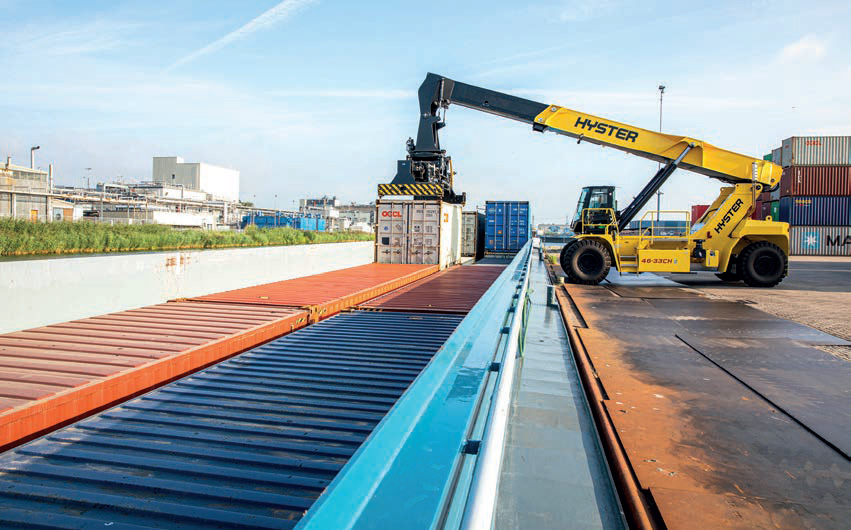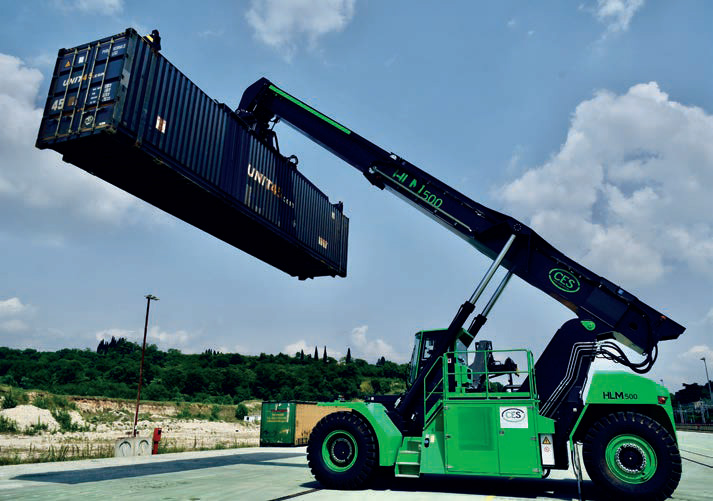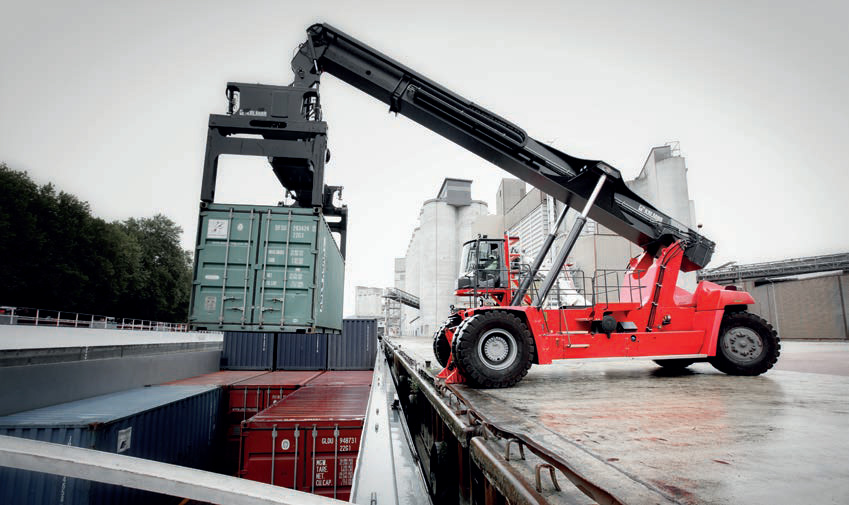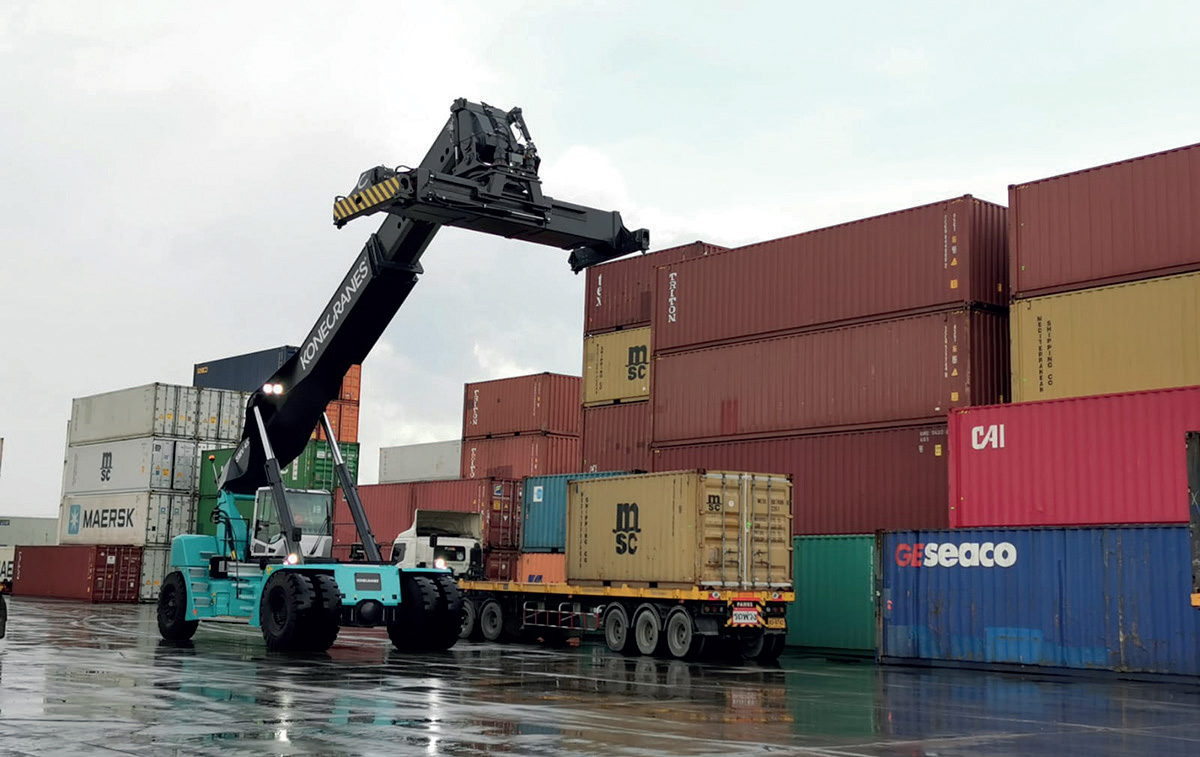Focus on fuel
10 July 2020There is a strong innovation drive among reachstacker manufacturers, as they are looking to lower fuel consumption and carbon emissions. Julian Champkin reports.
Mobile harbour cranes are large pieces of apparatus, calling for large investment. Medium to large sized ports are the ones that use them most. Reachstackers are less demanding: “They are small, mobile and flexible, and they find their greatest application in smaller ports and quaysides,” says Patrik Lundbäk, director of sales and distribution at Konecranes.
Nevertheless, market demand is for reachstackers to be larger than before. “We have seen increased demand for larger reachstackers,” says Rainer Marian, Hyster’s director for big trucks EMEA.
Container ships are large and getting larger but he attributes it to another cause: “It is likely due to an increase in intermodal handling operations which require trucks to reach out to the second rail line, over the first one. The longer distance means that the truck must have a longer wheelbase and heavier counterweights. In fact we have recently worked on the heaviest reachstacker we have ever built, for a customer in Russia—a specially modified Hyster RS46- 41XLS reachstacker.”
Peter Olsson, director of sales support at Kalmar agrees: “We have been asked for machines with a capability to stack higher. With the mega-trend of urbanisation, and limited space at many existing terminals, we see a demand for higher stacking capabilities.
Kalmar can offer up to six high for laden containers and eight for semi-laden containers up to 12t.
“But not all customers are looking for this. Many inland terminals are located in more rural areas where a lot of space is available but local restrictions limit them to stacking only four high. To get more containers in the same yard, block stacking tends to go from two rows of containers between aisles up to three or even four rows per aisle. That of course needs longer reaches of boom.”
Giovanni Bolcato, managing director of Italian makers CES, says the company is planning to introduce a new super-heavy reachstacker with lifting capacity up to 250t. “We are focussing in this direction because demand is arriving from the wind turbine sector. That is pleasing to us, as it agrees exactly with our eco ideology.”
Indeed eco-consciousness seems a common quality among makers. Machines with reduced carbon footprint, moving towards and even achieving zero, are on their way and have been realised.
“A standard diesel-driven top loader uses about 16 litres of diesel an hour. A litre of diesel can be considered to emit 2.67kg of CO2. That leads to emissions of 42.7kg of CO2 per hour per reachstacker. On a basis of 3,000 operating hours, this is 128,000kg of CO2 per reachstacker per year,” says Willem Nieuwland, Big Trucks project manager for Hyster. Hyster’s research has led to two concepts of emissions-reduced reachstackers. Battery-powered versions are suited to low to medium duty cycles. Where there are fixed and scheduled break periods during which the batteries can be recharged, large Li-ion batteries will power the truck.
If there is also the possibility for ‘opportunity charging’, for top-ups during intervals where the reachstacker is idle, smaller capacity batteries can be fitted instead.
But for applications that need more flexibility, or have heavy-duty 24/7 operation, batteries alone are not sufficient. “A version with a fuel cell range extender will be the right choice there,” says Nieuwland.
These versions still have Liion batteries on board, but they are smaller ones. They carry in addition an onboard fuel cell which is powered by hydrogen, and which supplies electricity ‘on the run’ for the battery and motors.
“Hydrogen is a clean energy carrier which is easy to store, and when used produces no emissions other than heat and water. The size of the hydrogen tank allows a full day of operation without refilling. Filling time is similar to a diesel tank, and so will have no or only minor impact on the planning of container handling,” Nieuwland explains.
Nevertheless, both the allbattery and the battery-plus-fuelcell need some infrastructure changes at the customer’s quayside. Charging takes time.
Fast charging can be completed in one hour with currently available battery technology, but sufficient power for this must be available at the container terminal. Around 500kW of charging power is needed; a fleet of 20 trucks rechanging simultaneously—say at night, or during off-peak hours— would need a capacity of up to 12MW in a worst-case scenario. “It is enough power to run a small village,” says Nieuwland. “In some cases the on-site availability of electric power may not be enough to supply this.”
Hydrogen re-filling for fuel cells can be via an on-site filling station or by a mobile dispenser. Impact on the infrastructure can be minimal or large, says Nieuwland.
“Hydrogen availability might be the major factor. Globally, many projects are starting up which could lead to easy access to hydrogen for many users. The transition to renewable sources such as wind and solar power is leading to local storage of energy. This is giving a boost to the production and storage of hydrogen. Electrification is ready to happen,” he says.
Sany offer their H9 technology to reduce fuel consumption of their reachstackers, which range in capacity up to 45t. Jürgen Keller is their product manager. “The key to improvement is the cost per container moved,” he says.
“Lower fuel consumption and more containers moved per hour brings the cost per container down.
"It takes energy to lift a load, and you lose that energy when you lower it. Our H9 technology saves and stores that energy. Hydraulic cylinders raise the load, as normal.
But we have also a set of ‘lowering’ cylinders, smaller ones, which deflect the oil into accumulators that store it under hydrogen pressure. Four such accumulators are spread around the machine, totalling 132 litres in all, so that gives a lot of capacity. That pressurised oil is used to help raise the load next time. When we are lifting a load it gives up to 70kW of power, which is so much that it can almost lift the empty container and boom. So you don’t have to spend any fuel lifting those: the engine power is used only on the container contents.”
That in turn leads to further savings: “We don’t need more power for heavier loads. The extra cylinders give a boost, which means the main cylinders can be smaller in diameter, which in turn means they demand less volume of oil from the pump and the engine, and therefore not only take less power but raise the load faster as well. So you get a positive, virtuous feedback in savings of energy and emissions.
“And there are two other energy aspects: We have redesigned the spreader, which gives a weight saving of one tonne. That lets us make the front of the boom that carries it lighter by 0.5t.
So that makes 1.5t less weight to lift up and down. And the feedback works for us yet again: for every tonne you save at the front of the machine you can save another tonne at the rear on the counterweight. So we have 3t less to accelerate and decelerate around the dockyard, which again is a saving on fuel.
“A third fuel-saver is transmission to engine matching,” he says. “The logistics market has not in the past much focussed on this. Four-speed gearboxes rather than five have been the norm. But we have now matched our T30 transmission unit with a five-speed gearbox. That means the engine stays in the low range of rpm (revolutions per minute), which is more fuel-efficient. And we are keeping the 11-litre engine for the same reason. We have resisted the temptation to go down to nine litres because the 11-litre gives really good efficiency across the speed range: it gives maximum power and efficiency at lower revs.”
Kalmar claim to have pioneered the world’s first commercial reachstacker. Their present offerings are the Gloria range, the more basic Essential range, both with capacities of up to 130t, and their DRG100 for handling empty and semi-loaded containers up to 12t. They also have their Eco reachstacker.
“It is our latest addition and is the answer to many customers’ demands,” says sales director Peter Olsson. “It uses hydromechanical variable transmission, HVT, which dramatically reduces fuel consumption and at the same time offers improved productivity.
And that in turn provides lower operating costs and a smaller carbon footprint.”
“Fully electric and hybrid solutions are already a reality,” says Per-Erik Johansson, Kalmar’s technology manager for electrification. “However, I would estimate that more than 90% of the industry’s mobile equipment will still be diesel driven for years to come.” For which reason Kalmar stress that automation and automated data-collection can give eco-efficiency savings even in standard-drive machines. “Reducing fuel consumption in smaller equipment could have a huge impact while we develop pure zero-emission alternatives for reachstackers and other mobile equipment,” he says.
Kalmar’s goal is an all-electric future, with their entire portfolio available as electrically powered versions. “We already offer electrically powered options for all the larger cranes and empty container handlers and tractors. The development work is well underway for Kalmar reachstackers as well. The electrically powered reachstacker will be in place in 2021, with serial production possible fairly soon after,” says Johansson.
“In the meantime, I would remind users that biofuel is a viable option for all Kalmar products already today, although the availability of biofuel varies from country to country. We have been living on borrowed resources for far too long. Why wait another minute when so many feasible opportunities for CO2 reductions are already available?”
Konecranes offer three routes to reduced emissions, depending on how much customers wish initially to invest. “Requirements on reduced emissions do not come from customers in all the world at the same time” says Lundbäck.
“So we are still introducing cleaner diesel engines in some markets while in other markets customers are already asking for fossil free drive lines.”
In their Power Drive system the engine speed is electronically limited to 1,700rpm. In that way the peaks in fuel consumption are taken away. The hydraulic system has been modified to make sure that the machine maintains its productivity and speed of lifting.
Power Drive is said to reduce fuel consumption by 15%. The initial cost of the option is small and is recovered in the first year of operation.
Flow Drive, their second option, uses Hydromechanical Variable Transmission (HVT). It has greater initial capital cost but cuts fuel consumption by up to 25%. The manufacturer says initial investment is returned in year two. Most radical, with technological modifications that are more fundamental still, is their hybrid drive. What Konecranes claim as the world’s first hybrid reachstacker recovers energy from braking and lowering and stores it in a supercapacitor. The stored energy enables operation in so called ‘silent mode’ with the diesel engine switched off and propulsion and lifting powered by electric motors. The system reduces consumption and emissions by up to 40%. Capital costs are higher, but payback comes, they say, in year three of operation. Over an eight-year cycle the machine offers cost savings of 70% over conventional models. Lower servicing costs for the electrical drive line is an important part of this saving. Hybrid offerings are available for reach stackers of up to 45t capacity and reaches to stack containers five/six units high. Technology and requirements are always progressing.
Konecranes are future-proofing their reachstackers. Their system architecture allows elimination of the diesel engine in the course of time. “The hybrid is a fully-electric machine in operation. The system electrifies every flow of energy in the truck. Therefore in the future the diesel engine could be replaced by non-fossil fuels, batteries and fuel cells as more environmentally friendly electricity suppliers.”
Italian based CES is a company that is building big as well as eco-conscious. “Our superheavy HLM1800 reachstacker has lifting capacity up to 180t and can pick and carry at 5 km/h,” says Bolcato. “All functions of the machine can be automated through the installed software to optimise engine use and reduce consumption. So engine acceleration, for example, is based on the energy demand of the functions – lifting, accelerating, and so on – and is controlled handled from the joystick without using the accelerator pedal.
“There is energy regeneration: Slowing of the machine’s traction hydrostatic system brakes the machine and recovers energy for use on any other movements made at the same time, for example lifting. All our machines have hydrostatic transmissions, which deliver significant reduction in fuel usage. They give consumption rates of eight to ten litres an hour on our 45t reachstacker on intermodal terminal duties.
“For super heavy reachstackers, we use a front axle of our patented design; its independent and swinging wheels are optimal for load distribution and traction on all types of terrain. The system can be connected remotely with our service centre that can monitor the operation of the machine.”
Ports are expanding worldwide, and makers are vying to supply them. “There is very strong competition,” says Bolcato, “and we are seeing price-cutting.”
Covid-19 has affected global trade volumes significantly, but those who handle the trade intend to have the right equipment ready for the recovery.



